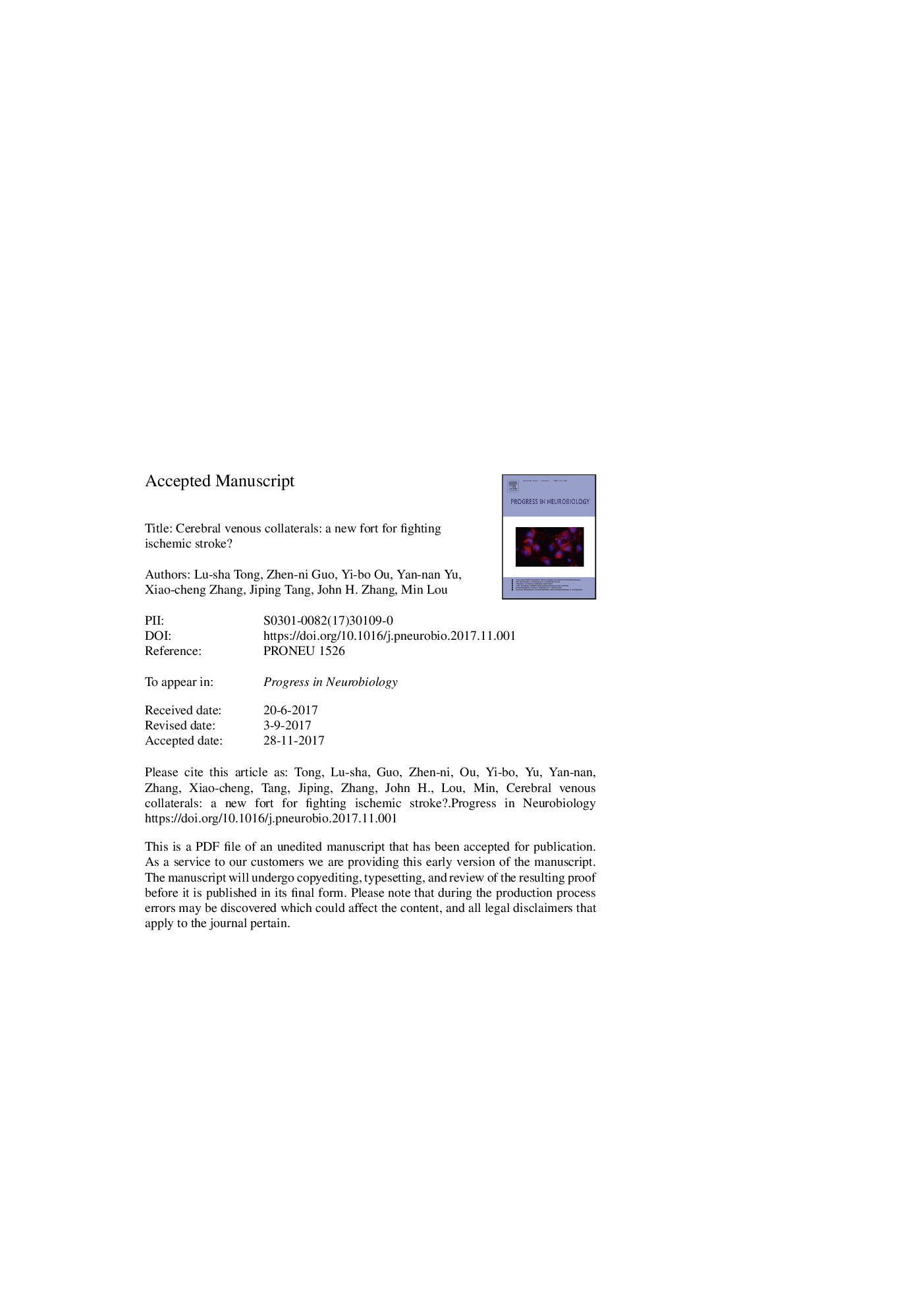| کد مقاله | کد نشریه | سال انتشار | مقاله انگلیسی | نسخه تمام متن |
|---|---|---|---|---|
| 8842185 | 1615352 | 2018 | 94 صفحه PDF | دانلود رایگان |
عنوان انگلیسی مقاله ISI
Cerebral venous collaterals: A new fort for fighting ischemic stroke?
ترجمه فارسی عنوان
عروق کرونر قلبی: یک قلعه جدید برای مبارزه با سکته مغزی ایسکمیک؟
دانلود مقاله + سفارش ترجمه
دانلود مقاله ISI انگلیسی
رایگان برای ایرانیان
کلمات کلیدی
t-PANIHSSDSAVCAM-1MCAOMIONCBFBasal vein of RosenthalAISBOLDBVRSWIICAM-1MVSSuperficial middle cerebral veinASITNDCTAICPMRVCPPCTVMagnetic resonance venography - venography تشدید مغناطیسیDigital subtraction angiography - آنژیوگرافی تفریق دیجیتالAmerican Society of Interventional and Therapeutic Neuroradiology - انجمن بین المللی نورولوژیست های مداخله ای و درمانی آمریکاmiddle cerebral artery occlusion - انسداد شریان (سرخرگ) مغزی میانیsusceptibility-weighted imaging - تصویربرداری با حساسیت پذیریcerebral blood flow - جریان خون مغزیEndovascular therapy - درمان آندوسکوکالPrecise - دقیقBBB - سد خونی مغزیIschemic stroke - سکته مغزی ایسکمیکacute ischemic stroke - سکته مغزی ایسکمیک حادCerebral Spinal Fluid - سیالات مغزی نخاعیintracranial pressure - فشار درون جمجمهایCerebral perfusion pressure - فشار پرفسور مغزیtissue plasminogen activator - فعال کننده بافتی پلاسمینوژنBlood-brain barrier - مانع خون مغزیCSF - مایع مغزی نخاعیNational Institute of Health Stroke Scale - موسسه ملی بهداشت سکته مغزیIntercellular adhesion molecule 1 - مولکول چسبندگی بین سلولی 1PCV یا Pneumococcal conjugate vaccine - واکسن کونژوگه پنوموکوکvascular cell adhesion protein 1 - پروتئین چسبندگی سلولی عروقی 1vascular endothelial cadherin - کادرفین اندوتلیال عروقی
ترجمه چکیده
سکته مغزی در عصر جدیدی با استفاده از درمان آندوسکوکی علاوه بر ترومبولیز وریدی وارد شده است. با این حال، اثربخشی رژیم های درمانی فعلی ممکن است با عوارض جانبی مرتبط با آن کاهش یابد. به عنوان مثال، بیش از حد مجدد و بازآموزی بی فایده ممکن است منجر به انفارکتوس بزرگ، تورم مغزی، عوارض هموراژیک و زوال عصبی شود. درک سنتی پاتوفیزیولوژیک بر سکته مغزی ایسکمیک می تواند به سختی به این موارد رسیدگی شود. شواهد جمع آوری شده نشان می دهد که یک تخلیه وریدی مغزی، مخزن اصلی خون و سیستم تخلیه مغز، ممکن است به عنوان تزریق شریان برای تکامل سکته و عوارض بالینی باشد. اکتشاف بیشتر عملکرد چند گانه ای از سیستم ورید مغزی ممکن است پیامدهای جدیدی را برای پیش بینی نتیجه سکته مغزی و تصمیم گیری درمانی در آینده به وجود آورد. در این بررسی ما بر ویژگی های تشریحی و عملکردی سیستم وریدی مغزی تاکید می کنیم و ضرورت آن در تسهیل انفوزیون شریان و حفظ پرفیوژن مغزی در محتوای سکته مغزی است. سپس، مطالعات بالینی اخیر انتقادی خلاصه می شود که ارتباط بین وثیقه وریدی مغزی و نتیجه سکته مغزی ایسکمیک را با تکنیک های تصویربرداری پیشرفته نشان می دهد. یک طبقه بندی جدید سه سطحی سیستم وریدی برای نشان دادن ویژگی های متمایز عروق کرونر در تنظیم سکته مغزی ایسکمیک پیشنهاد شده است. در نهایت، ما در مورد مسائل جاری برای ارزیابی کلسترولهای درونی مغزی بحث می کنیم و چالش ها و فرصت های آینده برای استراتژی های درمانی را با توجه به این مفاهیم جدید ارائه می دهیم.
موضوعات مرتبط
علوم زیستی و بیوفناوری
علم عصب شناسی
علوم اعصاب (عمومی)
چکیده انگلیسی
Stroke therapy has entered a new era highlighted by the use of endovascular therapy in addition to intravenous thrombolysis. However, the efficacy of current therapeutic regimens might be reduced by their associated adverse events. For example, over-reperfusion and futile recanalization may lead to large infarct, brain swelling, hemorrhagic complication and neurological deterioration. The traditional pathophysiological understanding on ischemic stroke can hardly address these occurrences. Accumulating evidence suggests that a functional cerebral venous drainage, the major blood reservoir and drainage system in brain, may be as critical as arterial infusion for stroke evolution and clinical sequelae. Further exploration of the multi-faceted function of cerebral venous system may add new implications for stroke outcome prediction and future therapeutic decision-making. In this review, we emphasize the anatomical and functional characteristics of the cerebral venous system and illustrate its necessity in facilitating the arterial infusion and maintaining the cerebral perfusion in the pathological stroke content. We then summarize the recent critical clinical studies that underscore the associations between cerebral venous collateral and outcome of ischemic stroke with advanced imaging techniques. A novel three-level venous system classification is proposed to demonstrate the distinct characteristics of venous collaterals in the setting of ischemic stroke. Finally, we discuss the current directions for assessment of cerebral venous collaterals and provide future challenges and opportunities for therapeutic strategies in the light of these new concepts.
ناشر
Database: Elsevier - ScienceDirect (ساینس دایرکت)
Journal: Progress in Neurobiology - Volumes 163â164, AprilâMay 2018, Pages 172-193
Journal: Progress in Neurobiology - Volumes 163â164, AprilâMay 2018, Pages 172-193
نویسندگان
Lu-sha Tong, Zhen-ni Guo, Yi-bo Ou, Yan-nan Yu, Xiao-cheng Zhang, Jiping Tang, John H. Zhang, Min Lou,
